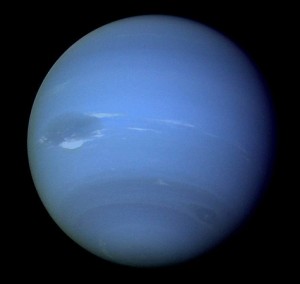Neptune is the eighth, and furthest, planet from the Sun (now that Pluto has been reclassified as a dwarf planet). Since Neptune is so far from the Sun, one Neptunian year takes 164.8 Earth years or 89,000 of Neptune’s 16-hour days.
Neptune is roughly eight times the diameter of the Earth and 17 times as massive. Neptune is similar in size and composition to Uranus and just slightly smaller, making it the fourth largest planet in the Solar System. Both Uranus and Neptune are classed as “ice giants”.
To find Neptune’s current position in the sky from your location, visit our Night Sky Simulator.
Neptune Stats:
- Type: Ice Giant
- Diameter: 49,244 km (7.8 Earths)
- Mass: 1.0243×1026 kg (17.1 Earths)
- Distance from Sun: 29.8 to 30.3 AU
- Sidereal period (Day length): 16 hours 6 min 36 sec
- Number of Moons: 14
- Symbol: ♆ (HTML alt code: ♆)
Neptune’s Discovery
Neptune’s existence was first predicted by Alexis Bouvard, several years before its discovery, from its gravitational effects on the orbit of Uranus. In 1846 Johann Gottfried Galle observed the new planet within 1° of where mathematian Urbain Le Verrier had predicted it to be, and about 12° from a position predicted by John Couch Adams; all three men are now credited with Neptune’s discovery. Many astronomers, including Galileo, had previously observed Neptune but failed to identify it as a planet, marking it on charts as a faint star.
Composition
Neptune, like Uranus, is classed as an ice giant planet. It is thought to consist of a rocky core – of similar mass to the Earth – a thick mantle of water, ammonia and methane ice and an atmosphere of hydrogen (80%), helium (19%) and trace amounts of methane, giving the planet its beautiful blue colour. White clouds of methane ice are often visible as well as storm systems such as Neptune’s Great Dark Spots – anticyclones roughly the diameter of the Earth, which appear to last several years at a time. Neptune’s high internal heat energy, compared to its sister planet Uranus, drives the fastest planetary winds in the Solar System.
Neptune’s Rings
Neptune, like the other giant planets in the Solar System, has a ring system, however the rings are faint and the outermost consists of five separate arcs, due to the gravitational effects of the moon Galatea.
Moons of Neptune
The 14 known moons of Neptune are listed below in order of increasing distance from the planet. At 2,710 kilometers (1,680 miles) in diameter, Triton is by far the largest of Neptune’s moons. The second largest moon, Proteus, is only around 400 km (250 miled) in diameter and has an irregular shape.
- Naiad
- Thalassa
- Despina
- Galatea
- Larissa
- S/2004 N 1
- Proteus
- Triton
- Nereid
- Halimede
- Sao
- Laomedeia
- Psamathe
- Neso
